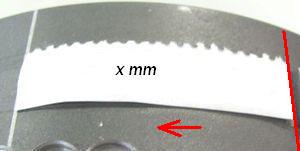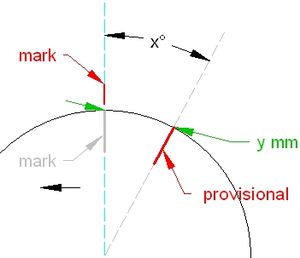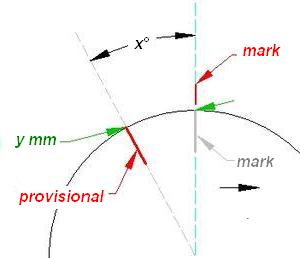Powerdynamo brings new ignition & light
to your vintage motorcycle
|
|
Powerdynamo brings new ignition & light |
|
|||
| using new PD flywheel as a timing disc | |
|
When setting a PD 2-stroke ignition during installation you need to set
your piston into the moment of ignition. This moment is given by the
manufacturer either in mm piston travel or degrees crankshaft turn. Note this is for systems without advance unit . On systems with advance unit, the procedure is different! |
|
|
|
|

|
You have no timing disc at hand or have trouble fixing it to your crank? You surely have the new PD rotor, which can be used as a disc. We have 3 different types of rotor in terms of diameter und as a result they have a different circumference which is easy to calculate (following rounded) rotor 103mm > 323.42mm / 360° = 0.898 mm/degree rotor 112mm > 351.68mm / 360° = 0.977 mm/degree rotor 128mm > 401.92mm / 360° = 1.116 mm/ degree |
|
As you now know how many mm on the circumference are 1 degree, you can
multiply this by the value needed and cut a piece of paper in this length. example: you need 28 degrees and have a 103mm rotor: cut a strip of paper with 28x0.9 = 25.1 (no need to calculate finer, you can not cut it that fine, 25mm length would do). You for this surely need to know how many degrees before top dead center your engine shall fire. You can unfortunately not convert mm piston travel into degrees, unless you know the dimensions of your crank (pitch circle of hub pin, length of conrod) |
|
|
|
|
|
|
First thing you have to do is to find TDC (top dead center - the highest
position the piston can get). Be aware that on some old engines you had
pistons with a shaped top which
can mislead you. Best use a gauge to find this, but a suitably sized screwdriver inserted into the plughole will also do. You will find that once you are at TDC you may move the shaft left and right without really effecting piston height. The middle between left and right position where you feel the piston drop is your TDC The point where ignition happens is ALWAYS before TDC. Something between 1 to 10mm before, depending on make. Make sure that you really get it before and not after. This will depend on turning direction. On clockwise operation engines you have to turn anticlockwise to get there, on anticlockwise operating engines turn clockwise. |
|
|
|

|
With anticlockwise turning shafts (for info see here) place the paper on the rotor drumīs circumference with its left edge against the rotor marking and make a provisional marking (line with marker pen, in the picture here drawn in red) at the other end of the paper. |

|
Verify that your piston is in TDC position and that you have placed the provisional marking correctly onto the rotor. Remember we are talking here about shafts turning anticlockwise. Place the rotor in such a way onto the crank (without disturbing its TDC position!) that the new, provisional marking aligns with the marking on the base plate. In this position fasten the rotor. When you now turn the rotor - now fixed to the shaft! - against running direction, that is clockwise until the manufactured markings align you have the position the install instructions give - without using a timing disc. |
|
|
|
|
|
With clockwise turning shafts (for info see here) place the paper on the rotor drumīs circumference with its right edge against the rotor marking and make a provisional marking (line with marker pen, in the picture here drawn in red) at the other end of the paper. |
|
|
|

|
Verify that your piston is in TDC position and that you have placed the provisional marking correctly onto the rotor. Remember we are talking here about shafts turning clockwise. Place the rotor in such a way onto the crank (without disturbing its TDC position!) that the new, provisional marking aligns with the marking on the base plate. In this position fasten the rotor. When you now turn the rotor - now fixed to the shaft! - against running direction, that is anticlockwise, until the manufactured markings align you have the position the install instructions give - without using a timing disc. |
|
|
|
| back to Knowledge base | |